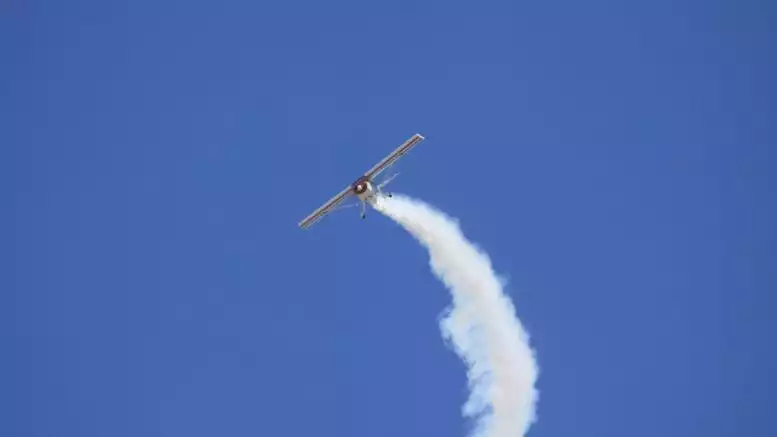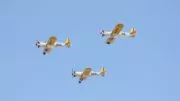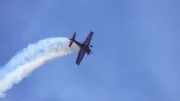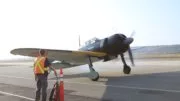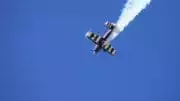What is Aerobatic Smoke Oil And Why Is It Used?
Aerobatic smoke oil helps spectators on the ground follow the action above their heads and adds a great deal of flair to an airshow. While it seems like an exotic part of aviation life, aerobatic smoke oil can be purchased off the shelf and even used in remote controlled airplanes. But what’s aerobatic smoke oil? What is its role? Let’s explore this exclamation point on air shows, which plays several different roles in aviation.
What is Aerobatic Smoke Oil?
Aerobatic smoke oil is a man-made contrail which is used largely in airshows and occasionally for other purposes. It’s mainly used for the following reasons:
Visibility for safety: Because it provides a controllable smoke trail, it is used so that spectators can follow the path of an airplane as it executes its maneuvers. The trail it leaves enhances what the pilot has just achieved. Most importantly, however, aerobatic smoke oil allows other pilots to see where other aircraft are relative to their own position. This is particularly important during group maneuvers. All members can follow one another’s trajectories.
Visibility for maneuver purposes: Sometimes the smoke trail is the point of the maneuver. It leaves patterns and a striking mark against the sky in specific designs. A spiral of smoke in the trail of a tight series of spins is particularly impressive.
Skywriting: There’s no skywriting without aerobatic smoke oil. Skywriting requires specially trained aerobatic pilots, as the control of the it is especially important. However, since skywriting is highly expensive for a client and TV and social media are seen by more viewers, skywriting is now rarely seen.
It looks cool: It also comes in many different colors. If you’ve ever seen the Air Force Thunderbirds, Navy Blue Angels, the Royal Air Force’s Red Arrows, you know how much it adds to a show. Sometimes show parachutists and sky divers such as the Army’s Golden Knights use a form of aerobatic smoke oil as well. These can add unmistakable flair for special events and group maneuvers.
Contrails vs. Oil
It’s easy to tell the difference between a natural contrail and artificial aerobatic smoke oil. Contrails are thin clouds which form in the wake of the hot engines of jets, although it is possible for contrails to form behind some piston engines. The term “contrail” is an abbreviation for “condensation trail”. They form from the water vapor a jet engine leaves behind, and sometimes from the pressure differential created by an airplane’s wings slicing through the atmosphere. Meteorologically, they are classified as high level clouds.
Depending on the number of engines the airplane has, as well as on the air swirls over the wing tip, contrails can last a matter of minutes, or sometimes longer, before evaporating. Contrails which hang for a while spread out and eventually become wispy cirrus clouds. Like aerobatic oil trails, the life contrails depends on many weather factors—temperature, wind, humidity, and other potential disturbances.
Oil and Aircraft Systems
This oil is a mineral oil which is paraffin based. Depending on the color the pilot wishes to use, a safe chemical additive is included. Professional aerobatic pilots can purchase it by the multi-gallon drum, although those who operate radio controlled airplanes and amateur aerobatic pilots who use it only occasionally can find it in lower quantities. Some even make their own. When a team uses aerobatic smoke oil in formation, consistency is key. The pilots use the same kind, although some might have different colors for a particular formation effect.
These systems require careful consideration by pilots and aeronautical engineers. They add weight to an airplane which is designed for maneuverability and quick turns; not only does the system increase an airplane’s weight, so does heavy liquid smoke oil. Even military aircraft, such as the F-18 Super Hornets used by the Blue Angels, require special retrofitting to allow for an appropriate system. The tanks of these systems must be able to withstand the high G forces of certain maneuvers, as well as safe containment as the aircraft performs fast, jolting turns which creates a great deal of sloshing.
In jets, the smoke oil system works with a fuel pump which transport the liquid from its tank to nozzles secured to the exhaust port. As the liquid oil comes into contact with the heated exhaust from the airplane, the oil burns, emitting its highly visible smoke. Oil dispersal is controlled by the pilot in the cockpit with a switch connected to the fuel pump. An electric pump is a major part of the array. For oil systems in turbine aircraft, the nozzle is located close to the turbine’s exhaust to produce a flammable mist. Just as with the jet system, the resultant burning oil makes for a bright artificial contrail.
Basics of Aerobatic Smoke Oil
Although a modern airshow without this addition is unthinkable, it’s a fairly recent addition to the line up. Smoke oil was first used in an air show in 1957 in Farnborough in the United Kingdom by the Black Cats, a Royal Navy helicopter demonstration team. For a time, diesel oil was used in aviation smoke systems. However, it was eventually discovered to have a negative effect on the bright paint schemes of aerobatic airplanes.
Modern aerobatic oil is biodegradable and non-toxic. Ideally, the oil has a low viscosity, which flows quickly and in a smooth line. This decreases wear on the smoke oil system and ensures that the intended color remains pure, without black tinges.
Since it is partially oxidized, ground crews and pilots know it must be handled as a potentially hazardous material. The smoke is formulated to vaporize completely. The mineral oils which are used as its base typically do not contain additives other than the safe compounds which are used to create a particular color. Airplane manufacturers encourage pilots and teams to use only certified oil so as to preserve the integrity of the system.
Ready to Soar with Us?

